
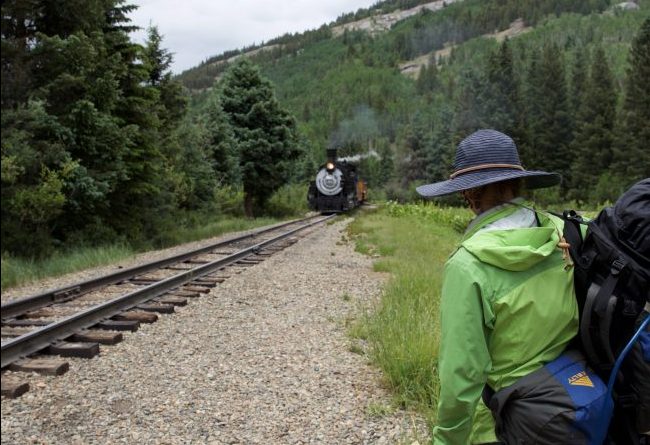
Starting the Trip
We step off the Durango-Silverton steam train exhausted and fulfilled, ready to submerge our bodies in hot water and celebrate our blisters after a phenomenal backpacking trip.
Durango, Colorado is alive. Blues guitar plays from the rooftop patio of one of the local breweries, the plants are in mid-summer bloom.
An actual horse-drawn stagecoach pulls past us as we cross the street (complete with a Australian Shepard riding shotgun). We feel ecstatic to be back in civilization.
My wife and I had awoken that morning in the impossible beauty of Vestal Basin, high in the backcountry of the Rocky Mountains near Silverton, Colorado.
In my mind, this is the best landscape the United States has to offer. Our three-day excursion had been successful, although grueling.
We’re delighted that the weather allowed us to summit Arrow Peak, although just barely.
After packing out via the Elk Creek trail, the 1890’s-era steam train picked us up at a pit stop halfway between Silverton and Durango, mercifully sparing us the work of ascending the 36 switchbacks back to the road.
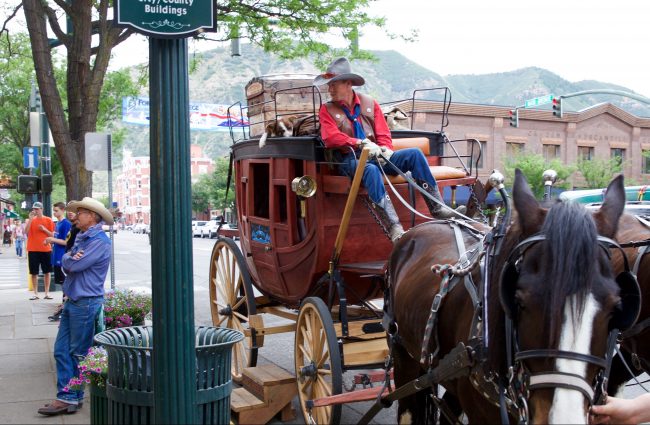
The old, coal-burning train follows the crystalline water of the Animas River through wild areas deep in the Colorado Rockies.
Many people will never have access to these areas because their bodies simply can’t get them there. From how my legs feel, mine barely managed the trek.
I’ve lived in Durango before. Coming back to the delightful little town is like cheating: I know all the cool spots. We head directly for the Thai place next to the train station, ravenous.
Sizzling Siam is an easily overlooked hole-in-the-wall of the Old West storefronts. It’s our favorite, though we debated sushi.
The ecstasy of a return to civilization after an extended backcountry trip is unique, and only understood by outdoors enthusiasts. Soft beds. Beer. Live music. Good food – food other than lentils and Clif bars.
Durango, Colorado
Durango is all these things distilled together. The town hits us as a wall of entertainment and sensual delights.
Craft breweries line the main drag along with art galleries, ice cream parlors, bike shops and the requisite tourist t-shirt vendors.
Wild and wonky bikes are everywhere, some costing more than our car. Durango is a mountain bike Mecca, and continually debates the title of “Birthplace of Mountain Biking” with Marin County in California.
In reality, both places originated mountain biking at about the same time. Marin County may boast, but you can’t say the Durango locals here weren’t bombing down the hills in the ‘80s on modified cruiser bikes.
Within the city limits, you’re never more than a 10-minute ride to a world-class mountain bike trail.
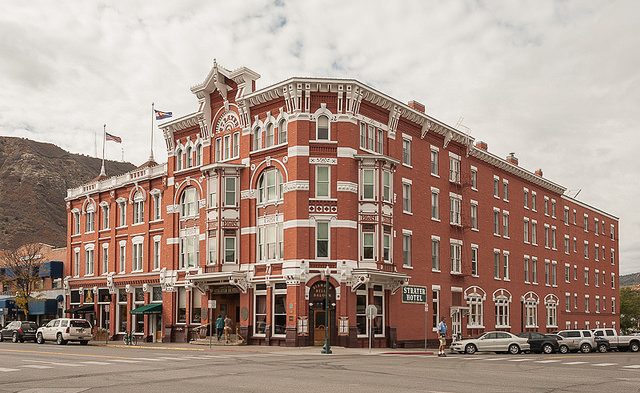
Strater Hotel
We don’t have time or energy for biking, but do have a room waiting for us at the historic Strater Hotel, a gorgeous restoration of Victorian era architecture and décor.
It’s a damned nice place, and I’m a dirty man with a dirty backpack. The disparity pleases me, and I get a warm, casual greeting from the kid at the desk, as though he approves of how I’m living my life.
He’s probably a little jealous of wherever it is I’ve been. The town is full of ski bums working subsistence jobs with their lives on hold just so they can be here, in this place now, biking, kayaking, and drinking beer priced well outside their means.
The Strater Hotel is nearly as old as the town itself, with just as many stories to tell. The hotel was built in 1887 and was the flagship hub for Durango’s community of miners and frontiersmen.
During the winter months, many local residents chose to stay at the Strater because it was one of the few well-heated buildings in the area.
During Prohibition, someone was secretly brewing in a stile hidden beneath the elevator shaft. John F. Kennedy slept here, possibly in the same bed we’re about to.
The lobby is walnut burl and wingback chairs, intricate stained glass and undulating patterns of wallpaper.
Bellmen dress appropriately to the time period, and the girl waiting tables in the adjoining saloon is scantily dressed as a barmaid. From the looks of things, she’s killing it on tips.
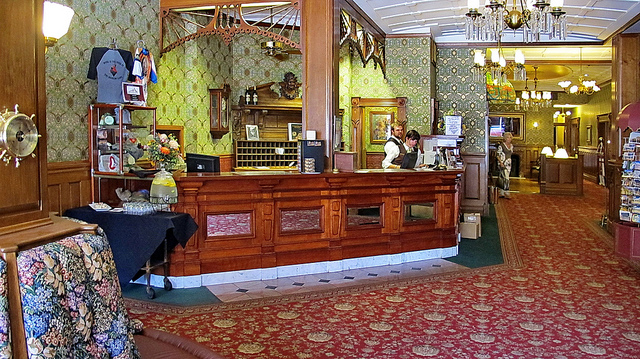
A television is the only element of our room that betrays the anachronism of the 1890’s. It’s great that the hotel has maintained this Old West experience.
We walk up Main Avenue: college kids, locals sitting outside coffee shops, scuzzy rucksack wanderers with guitars in tow, organic farm-to-plate restaurants, and live music performances are everywhere.
It’s not yet the weekend, but the place is lit up with summer activity.
A music festival is playing at Buckley Park. People dance in the grass, food trucks circle, and the steel guitar of country music twangs from a stage of performers that look more like an indie rock band than cowboys.
Evening at the River Path
Being ex-locals, we choose to cut over to the river path. The evening is calm on the water as the mayflies hatch and the sun sets. It’s a perfect time for trout, though there are no fly fishermen at the moment.
A brown trout caught directly below the stone concaves of Main Avenue Bridge held the state record for a long time.
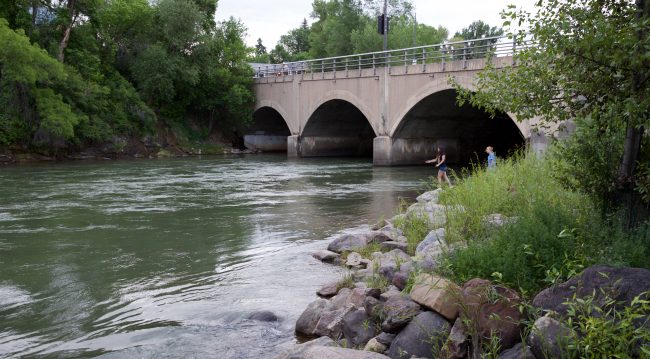
As we pass under Main, the swallows swoop low to build their nests below the overpass, and we marvel at the foliage on the opposite bank.
Parts of it are so thick and wild it’s hard to believe we’re inside the city limits. The backcountry we just came back from once encompassed the entire township, and parts of it still exist in patches.
The path is a continuous stretch of concrete that extends throughout town and down past the kayak park.
It’s a true friend to the commuter cyclist, and a great way to see the city if you’re visiting. Cruiser bikes are available for rental from the many of bike shops.
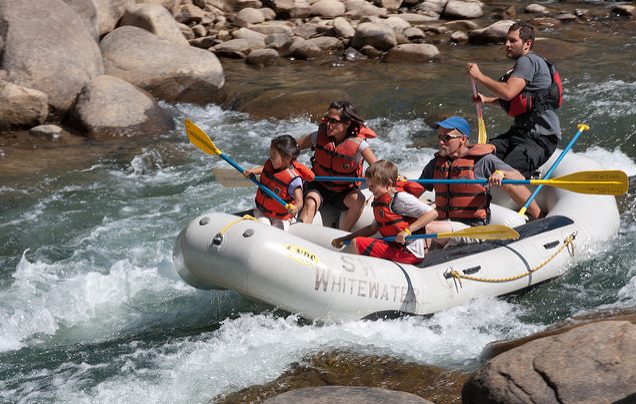
The kayak park is at the base of Smelter Mountain, and the eponymous rapids are the grand finale of the whitewater rafting tours.
If there’s a spot that’s going to flip the boat, Smelter’s it, and the photographers are waiting, though the action seldom turns disastrous.
That said, my expensive sunglasses are still down there someplace, forever nestled underwater in the rocks.
Smelter Mountain has an important place within Durango’s history too. The gold and silver ore that was found in the mountains was transported via the train down into Durango and processed on the banks of the Animas River.
This was the original purpose and livelihood of the encampment.
Visiting the Town
During World War II, uranium ore was found in the Four Corners area, and the Smelter facility was used to process it for use in the atom bombs that were dropped on Hiroshima and Nagasaki.
The tiny town of Durango was actually on Hitler’s list of places to strategically bomb.
There’s something going on at the Durango Children’s Museum too. The town’s really doing it up on a Thursday night, more so than I remember.
It’s some gala dinner and a guy with a microphone describing an astrological event that sounds pretty boring.
The actual structure is really cool though: it was the original Durango DC electric generation facility. The smokestack still stands, though the museum is solar powered now.
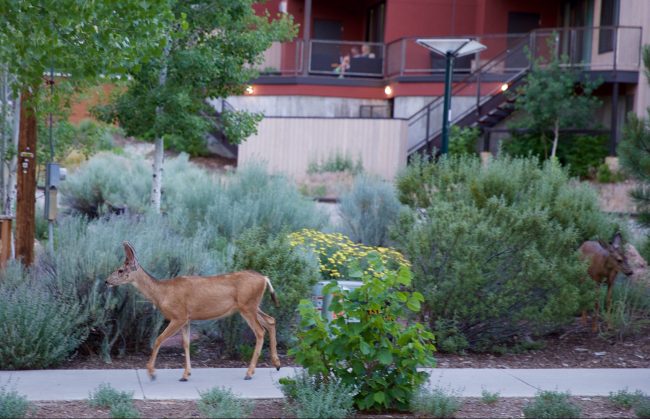
While walking back to Main, we see two young deer grazing on the landscaping outside one of the breweries. The camera phones of the people on the patio all come out, but deer are a pretty common sight within the city limits.
When we lived here, we grew tired of the animals I termed “the idiots,” and we both wished they did a better job of staying out of the road.
All the same, it’s incredible how the wilderness mingles with the town in Durango – that’s why people are drawn here, and why my wife and I find ourselves contemplating a move back.
Durangotangs, as the locals are called, know a good thing when they find it.
If You Travel to Durango:
Ride the train, but get off it. Spend the night camping in an incredibly remote place that you didn’t have to hike too, or hike further in and have the world to yourself.
If you’re there in the spring, go rafting. But if you visit in late summer when the Animas is low, go tubing.
Floating from the north end of town to the south in an inner tube is a great way to beat the heat. Ask about tube rental at the raft shops.
Helpful Info: Durango.org
Author Bio: Jack Bohannan is a freelance writer and former resident of Durango now living in the Denver area. Read more of his work at GoAdventureTravel.com
